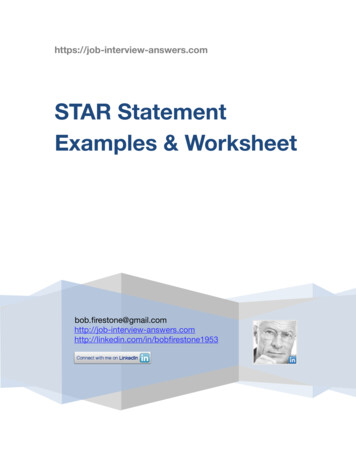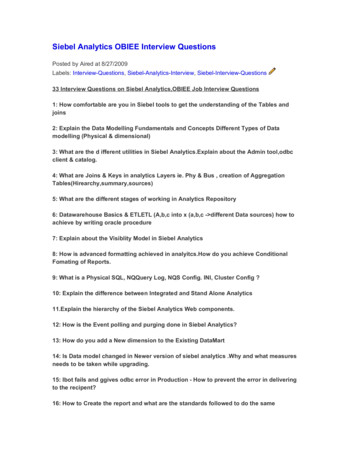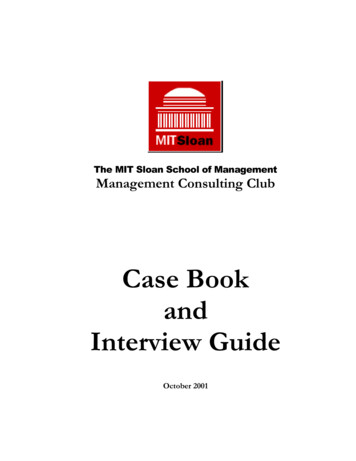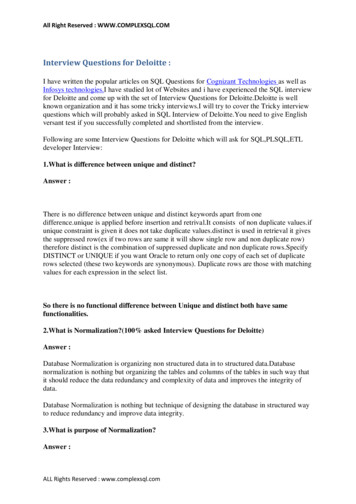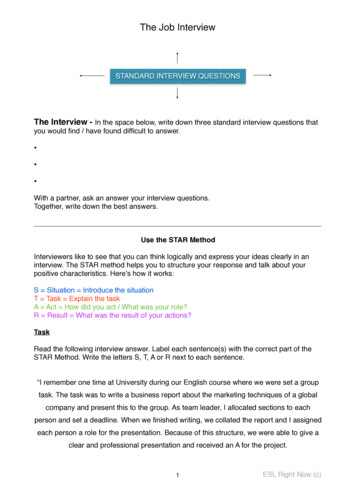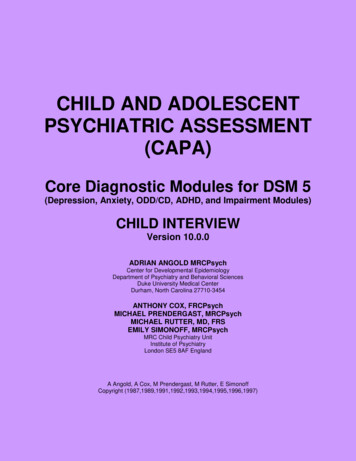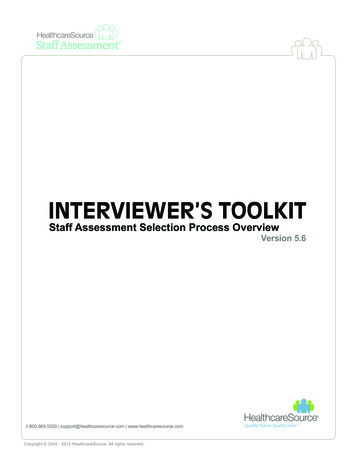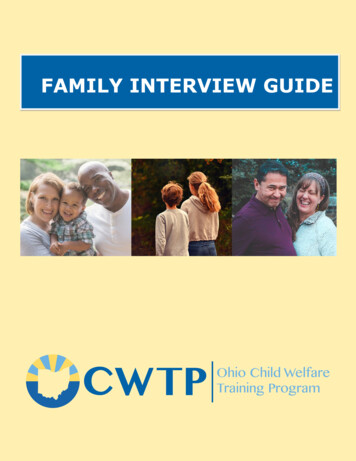
Transcription
FAMILY INTERVIEW GUIDE
Using the Family Interview GuideThis guide provides sample questions to help conduct interviews with prospectiveadoptive parents, foster caregivers, and kinship caregivers. Interview questions needto be tailored to the families being interviewed, and follow-up questions need to beformulated based on responses. These questions give Assessors a starting point asthey gather assessment data and guide the family through a process ofself-assessment in the foster care and adoption application process.Developed by the Institute for Human Servicesfor the Ohio Child Welfare Training ProgramJuly 2020Material in this guide has been adaptedfrom the following sources:The Field Guide to Child Welfare,Vol II, Case Planning and Family-Centered Casework, andVol. IV, Placement and Permanenceby J. Rycus and R. Hughes(Child Welfare League of America Press, 1998)Family and Child Assessment, Tier I AssessorCurriculum, Ohio Child Welfare Training Program, revised 2015, 2019, 2020Foster Care, Kinship Care, and Adoption Preservice Training,Ohio Child Welfare Training Program, revised 2015“Promoting Normalcy for Children and Youth in Foster Care”Juvenile Law Center 20152Third Edition, July 2020
3Third Edition, July 2020
What is a Family Assessment?The purpose of the Family Assessment, also known as the Home study, is for theAssessor and the applicant to mutually determine the appropriateness andreadiness of the family for foster care or adoption.The goals of the family assessment are to:Agencies use a variety of assessment opportunities including:4 Individual and family interviews Observation of the applicant at Preservice training and other group sessions Criminal record checks, personal, relative, and employment references which mayinclude credit reports and physical and mental health evaluations The Assessor’s own experience with the family Statewide Automated Child Welfare Information System (SACWIS) database searchThird Edition, July 2020
Description of Assessment FormsThe joint foster care and adoption Homestudy document Assessment for ChildPlacement (JFS 01673), which became available in Ohio in 1996, made it possible foran applicant to be simultaneously approved for both foster care and adoption. TheHomestudy is a comprehensive tool used to determine the applicants’ readiness andappropriateness for foster caregiving and/or adoptive parenting.A completed family assessment includes the following attachments: Application for Child Placement (JFS 01691)Medical Statement for Foster Care/Adoptive Applicant and AllHousehold Member (JFS 01653)Three personal references from those who do not live with applicantOne relative referenceA Fire Inspection Report for Homes or Residential Facilities Certified/Approved by ODJFS (JFS 01200 )Safety Audit of a Foster Home (JFS 01348)Applicant Financial Statement (JFS 01681)National Sex Offender Search Results (OAC 5101-2-7-02)BCI and FBI reports as outlined in the (OAC 5101:2-5-09.1)Completed water test, if the family has well waterThe Large Family Assessment (JFS 01530), if applicableThe Child Characteristics Checklist* (JFS 01673-A)*The Child Characteristics Checklist is completed by applicants, not theAssessor, and is attached to the JFS 01673 form. Applicants mustspecifically indicate whether they will or will not consider a child who hascertain characteristics identified on the JFS 01673-A.Assessors should check with their agency regarding anyadditional agency or county documents.5Third Edition, July 2020
DiversityHow does diversity impact the assessmentprocess?Diversity refers to allthe characteristics thatdistinguish one personfrom another.Diversity competence is:The capacity to relate to persons with diverse characteristics in a sensitive, respectful, andproductive way.An ongoing developmental process that includes: An acquired understanding of the patterns and potential dynamics of diverse groupsand cultures, including our own The understanding of how culture (the values, beliefs, attitudes, and traditionsacquired from affiliate groups), and other circumstances influence our own and otherpeople’s thinking and behaviors The ability to manage and adapt to the dynamics of difference, and work effectivelywith all peopleAssessors will serve clients from vastly different backgrounds than their own. While it may beeasy to dismiss another’s diversity as “wrong” or “inappropriate,” the Assessor must providenon-discriminatory and competent services to each family and child on his or her caseload.Skills in relationship-building and communication are essential during the interview process andgreatly enhance the quality of the mutual assessment. Prospective families and caregiversshould be assessed within the context of their own diversity. To reduce the chance of aninaccurate assessment, Assessors must consider different communication and interactionstyles, nonverbal behaviors, differences in the use and meaning of specific words and phrases,family roles and relationships, and home environments.6Third Edition, July 2020
Sound foster care and adoption practicebegins with a commitment from theAssessor to provide diversity-competentservices.7Third Edition, July 2020
Engaging the Family in AssessmentA critical first step in Family Assessment is engagement, a process of putting the family atease, drawing its members more comfortably into the process, and building trust and rapport.Successful engagement increases the likelihood of a more effective assessment outcome.Some strategies to successfully engage foster and adoptive applicants include: Respect the family’s diversity Establish a clear purpose for each interview Determine where the family feels most comfortable in holding interviews Determine how the applicants prefer to be addressed Ask open-ended questions that are general in nature to allow applicants anopportunity to express themselves Display a non-judgmental attitude Vary the intensity of the interview so that there is a balance between more probing,personal questions and more superficial ones Seek opportunities to compliment the family about their children, home, activities Acknowledge the family pet(s) Be sure to answer the family’s questions and address their concerns during eachcontactThe Assessor should: develop diverse,effective, efficientverbal, non-verbal andobservational skills. utilize a variety ofinterviewingtechniques.8Third Edition, July 2020
Interviewing MethodsAn Assessor should make an effort to ask behavioral rather than theoretical questions.Theoretical questions typically elicit responses the applicant feels the Assessor wants tohear, and these questions provide relatively limited insight into the applicant’s strengths orchallenges.Behavioral questions, on the other hand, focus on actual events in the applicant’s history.They are founded on the understanding that an excellent predictor of future behavior is pastbehavior. Asking applicants how they have handled similar situations in the past will give theAssessor (and the applicants) a much clearer picture of their readiness for adoption or fostercare.9Interviewing MethodDescriptionExamplesClosed-ended, probing or yes/noquestionsAllows Assessor to gather specific informationfrom applicants“What is your birth date?”Open-ended questionsAssists Assessor in gathering a broad range ofinformation including insight into applicants’feelings and perceptions“Tell me about your childhood?”Supportive responses - Active listeningBuilds trust between Assessor and applicants;Encourages applicants to be honest in theinterview“It must be difficult to accept that you cannothave children biologically.” “Sounds like youhave thought about adopting or caregivingfor a very long time.”ClarificationHelps Assessor accurately interpret applicants’responses; Assist applicants in gaining insight intotheir own feelings and perceptions“You believe that you have a good marriage;What does that mean?” “Sounds like you arefeeling very ambivalent about a school-agechild. Can you tell me more about that”?Summarization-RedirectionHelps to maintain focus and organization duringinterview; Assists Assessor in moving interviewalong and using limited time efficiently“Now that you’ve talked about yourchildhood, let’s hear about your life as amarried person.” (redirection) “You’ve toldme three things that you consider strengths:your parenting experience, high energylevel, and positive relationship with theschool system.” (summarization)Giving options, advice or suggestionsAllows Assessor to serve in a supportive role toapplicants“I can see that your heart’s set on adopting anewborn. Our agency only places olderchildren with special needs. Let me give youthe names and numbers of agencies whocan help you.”ConfrontationNecessary when Assessor feels applicants havebeen resistant or have not been completelyhonest in responses“I don’t believe that you are giving me all thedetails about the extent of the abuse yousuffered as a child.”“How long have you been married?Divorced”? “How old are your children?”“Describe your spouse to me.” “Why are youinterested in this type of child?”Third Edition, July 2020
Documenting the AssessmentIt is critical that the Homestudy document is well written, descriptive, concise, and clear inorder to ensure that children and families receive appropriate placement services. Thefollowing are a few tips to assist in writing the family assessment:Use words that give an exact meaningToo often assessors use state ments like:“They have a stable marriage” “They have a good relationship” “It is a nice house.”What do “stable, good, and nice” really mean? It would be more ac curate to say:“Like any other couple, Fred and Mary have had their ups and downs. They both agreethere have been few major disagreements and they have been able to compromiseeach time. Neither can stay mad very long.”“While small in size, the Collins home is cozy, neat and comfortable. It is well-lit, organizedand has a fresh coat of paint inside and out.”Get rid of extra wordsSome writers are verbose and wordy. The reader must wallow through unnecessary words toget important information. For example:“Robert attended North High School and graduated in 1983. He played football, baseballand basketball. Linda attended North High School and graduated in 1983. She was acheerleader and was in the choir.”With editing, unnecessary words and phrases are eliminated:“Both Robert and Linda attended North High School, graduating in 1983. Robert lettered inthree sports, while Linda was active in cheerleading and choir.”Do not use slang, “lingo”, or jargonThis is not professional, and others reading the assessment may not understand these terms.Phrases such as “He’s a smooth talker” may not be accurately interpreted. Use “He’s anarticulate and colorful speaker” instead.Give complete informationSome writers try to cut corners and leave out valuable information. Frequently, informationregarding the foster/adoptive family’s neigh borhood, culture, personal interests and infertilityissues is scanty and insufficient. A four-word sentence does not adequately relate informationabout important topics.10Third Edition, July 2020
Large Family AssessmentOhio Department of Job and Family Services (ODJFS) rules require a large family assessmentbe completed at the time of the adoption Homestudy when there will be a total of five or morepermanent, kinship, foster, or adopted children (ages 0-18) in the home, based on the numberof children the family is being approved forThe large family assessment evaluates the ability of the family to meet the needs of additionalchildren while continuing to meet the needs of children already in the home. While this isrequired for adoption, it is a good practice to conduct the large family assessment for fosterand kinship applicants as well. These considerations apply to all potential families, regardless offamily size but take on special significance in large families.Example: A family currently has two children in the home.They are going to be approved for three additional children.A large family assessment is needed because there wouldbe a total of five children in the home.Issues to consider in a large family assessment include: 11Living space arrangementsChildren currently in the home (ages,personalities, special needs, attitudes of childrentoward the proposed adoption)The prospective adoptive child (special needs)Parents’ capacities and motivation for wanting alarge family (availability to supervise children,family lifestyle, organization of the household,plans in place should parents die or otherwisebecome unable to parent)Resources and supports (support from extendedfamily and community, resources available incommunity, financial stability of family)Family history and experience (length of timesince last placement, placement history ofprospective adoptive home, demonstrated abilityto ensure prospective child’s safety andwell-being)References (additional references from professionals or service providers regardingthe family’s ability to meet the needs of children)Third Edition, July 2020
Criminal HistoryNon-Rehabilitative OffensesAccording to Ohio Administrative Codes (OAC) 5101:2-5-09.1 OAC 5101-2-5-09-1 and 5101-27-02 there are crimes that automatically disqualify an applicant or foster caregiver.For a complete and detailed list of disqualifying crimes can be found inAppendix A of 5101:2-7-02.Regarding non-automatically disqualifying Felony convictions after five years and misdemeanoroffenses, the assessor must evaluate these charges or convictions using the rehabilitativecriteria in paragraph (K) of rule 5101:2-7-02 of the Administrative Code.Rehabilitation StandardsAccording to the Ohio Administrative Codes (OAC) 5101:2-7-02 and 5101:2-48-10, certainrehabilitative standards must be met when an applicant for foster care or adoption, or a mem ber of their household, has a conviction for certain crimes. Those crimes are listed in AppendixA to rules 5101:2-7-02 and 5101:2-48-10 of the OAC. These standards also apply to records ofconvictions that have been sealed or expunged. The burden of verifying that these rehabilita tion factors have been met falls to the applicant.According to 5101-2-7-02, the rehabilitations standards considered are as follows:The victim was not a person under the age of eighteen.Consider the following factors:person's age when the offense occurred.nature and seriousness of the offensecircumstances under which the offense was committeddegree of participation of the person involved in the offensetime elapsed since the person was fully discharged from imprisonment or probationlikelihood that the circumstance leading to the offense will recurIs the person a repeat offender?employment recordEfforts and results at rehabilitationAre any criminal proceedings are pending?Whether the person has been convicted of or pleaded guilty to a felony contained inthe Revised Code that is not listed in appendix A to this rule, if the felony bears adirect and substantial relationship to being a foster caregiver or adult member of thecaregiver's household.Was the victim of the offense: a functionally impaired person as defined in section 2903.10 of the Revised Code. a developmentally disabled person as defined in section 5123.01 of the Revised Code a person with a mental illness as defined in section 5122.01 of the Revised Code A person sixty years of age or olderAny other relevant factors 12Third Edition, July 2020
“No No’s”In addition, there are certain behaviors not specifically included among those in the OAC asnon-rehabilitative, but, as best practice, should be categorized as behaviors that put childrenat risk, and therefore, should automatically preclude an applicant from becoming a fostercaregiver or an adoptive parent. These behaviors are commonly referred to as “No Nos .”Examples include: Histories of sexually abusive behaviors which put children at risk of further abuse. An applicant’s current substance abuse creates a chaotic and unpredictable homeenvironment inappropriate and threatening to children. The home environmentmay also be unsafe due to drug trafficking activities or neglect when the applicantis “high.” Severe mental illness which would interfere with either parent or ceregiver’s abilityto meet the child’s needs. Illnesses that are untreated or not controlled withmedication severely limit a person’s capacity to parent. Current, ongoing domestic violence which involves physical or emotional abusedirected toward any member of the family.13Third Edition, July 2020
Second Look IssuesThere are many other situations which warrant a more in-depth as sessment or a second lookby the Assessor. It is critical, however, that each applicant be assessed individually, as rigidand over-generalized standards prevent Assessors from understanding the wide variance offamily situations. In-depth assessments are necessary when the following situations occur:History of being a perpetrator of physical abuse, sexual abuse or neglect. This may besubstantiated or strongly indicated. This information is generally uncovered as pastagency history, police reports and poor references. This needs to be reviewed thoroughlyto assess the circumstances of the abuse or neglect and the potential for further abuseor neglect.History of domestic violence should be further assessed to determine the scope, copingstyles, duration, and long-term patterns which have emerged as a result of violencewithin the family.Recurrent arrests and convictions should be explored further with the applicants todetermine whether the arrests involve a disqualifying offense. Other convictions may bepermissible if the applicant has completed rehabilitation standards.Unresolved personal issues related to childhood victimization. These issues may berelated to physical abuse, sexual abuse, neglect, abandonment or rejection and willresurface when parenting. Unresolved issues may cause a repeat of abuse and neglect orrender the applicant incapable of healthy parenting.Rigid or inflexible beliefs. For example, applicants may believe that birth parents areunable to parent their children, or that “punishment” is always the best strategy formisbehavior.Marital difficulties, including a history of repeated separations or divorces, or indicationsof ongoing conflict between adult partners, may create an environment potentiallythreatening to a child’s well-being, permanence, or even safety. Applicants whodemonstrate a pattern of leaving relationships when obstacles appear may bedemonstrating their inability to make a life-long commitment to a child. Further, it mayindicate that adults who have unresolved or unhealthy conflict in their intimaterelationships may have experienced trauma and lack the emotional energy or support toappropriately meet a child’s needs.Child-rearing problems in parenting children currently in the home or a history of parent ing problems with minor or adult children should be thoroughly explored to ensure thatdiscipline, nurturance, or supervision problems have been addressed and resolved.A history of mental/emotional problems (including depression, personality disorders,anxiety, etc.) could be indicators of threats to the child’s safety. To ensure that aprospective child will be safe, and the prospective parents or caregivers have thecapacity to meet the demands of parenting, Assessors may require the applicant(s) toprovide a statement from a therapist, indicating the current level of functioning of theapplicant(s), steps taken to address the mental health issue, and potential triggers for arecurrence.14Third Edition, July 2020
Physical health problems (chronic illnesses or conditions, physical challenges) may alsoimpair a prospective applicant’s ability to meet the needs of a child. Assessors may askapplicants to provide additional information or recommendations from health careproviders regarding the impact of parenting on the prospective applicants’ physicalhealth as well as an assessment of the applicants’ capacity for providing care forchildren.Marital difficulties, including a history of repeated separations or divorces, or indicationsof ongoing conflict between adult partners, may create an environment potentiallythreatening to a child’s well-being, permanence, or even safety. Applicants whodemonstrate a pattern of leaving relationships when obstacles appear may bedemonstrating their inability to make a life-long commitment to a child. Further, it mayindicate that adults who have unresolved or unhealthy conflict in their intimaterelationships may have experienced trauma and lack the emotional energy or support toappropriately meet a child’s needs.Child-rearing problems in parenting children currently in the home or a history ofparenting problems with minor or adult children should be thoroughly explored to ensurethat discipline, nurturance, or supervision problems have been addressed and resolved.In order to help the Assessor, explore any of these areas ofconcern more fully and accurately, it is recommended that thefollowing questions be addressed by the Assessor and applicants:15Third Edition, July 2020
Assessment CategoriesAttitudes and beliefs regarding foster care andadoption issues – the applicants’ ability to viewthemselves as resource families for children who entertheir home, and as team members rather than consumersof services. They are strong child advocates and supportthe child welfare goals of safety, permanency, and wellbeing for children.Motivation to foster or adopt - the applicants’ability to understand appropriate and inappropriatereasons for adoption and foster caregiving withanticipated outcomes as determined by two basicquestions: Why do you want to adopt or foster? And whydo you want to adopt or foster now?Personal and emotional maturity - the applicants’ability to put another’s needs before their own without feeling personally threatened orexperiencing severe emotional stress.Stability and quality of interpersonal relationships -the applicants’ abil ity todevelop, maintain, and sustain healthy interpersonal relation ships. In a two-parent home,the relationship of the applicants must be strong enough to withstand the demands ofparenting.Coping skills and history of stress management – the applicants’ ability to functionproductively in high stress situations. Foster caregivers and adoptive parents should have avariety of effective strategies to cope with the changes and stresses inherent in the adoptionor foster care process. They should also possess the ability to acknowledge the impacttrauma has on their life, recognize when they have been triggered and use coping skills toeffectively manage the resulting emotions.Level of openness in family relationships - the applicants’ ability to be flexible in bound aries and respond to challenges from within and outside the family system. Openness isalso indicated by the family’s receptiveness to community and professional services, ifneeded.Parenting skills and abilities - the applicants’ ability to care for children and provide thenecessary nurturing, discipline, and guid ance appropriate for the age and functioning of thechild. Although applicants with children have experience in parenting and, in general, arebetter prepared, caring for a child from the child welfare system can present additionalchallenges.Ability to empathize with others – the applicants’ ability to relate to and understandanother person’s situation, feelings, and motives. This is particularly important whenparenting chil dren who come from backgrounds of abuse or neglect.16Third Edition, July 2020
Understanding of entitlement issues - the adoptive parents’ ability to accept they havethe full rights and responsibilities to parent a child not born to them. Feeling entitled allowsadoptive parents to lovingly discipline, to make important decisions, and to intervene onbehalf of their child(ren).Entitlement also refers to the foster caregivers’ ability to believe they have the right and re sponsibility to facilitate age and developmentally-appropriate experiences for children andyouth in care. They acknowledge their duty to make reasonable and prudent decisions thatenhance development and support normalcy.Ability and willingness to take a hands-on parenting approach – the applicants’ability to model (vs. verbally instruct) appropriate behaviors for the child and to use concretebehavior management techniques of a more cognitive nature. Parenting children with a historyof trauma often requires close supervision, interactive instruction, modeling, redirection, andpurposeful play to build attachments.Ability to make and honor commitments - the applicants’ ability to see the child as afamily member. This category includes exploration of long term identity issues common toadoptees and children in foster care, issues of birth family search and reunions, “leaving thenest,” and expectations for future education, self-sufficiency, family connections, etc.Religious affiliation and/or spiritual beliefs – The applicants’ ability to acknowledge andrespect the magnitude of spiritual and religious diversity that exists, and their willingness toaccommodate the practices and needs of children and their families.17Third Edition, July 2020
Continuum of FunctioningNot every applicant family is capable of caregiving or adopting. The mutual assessment processis designed to provide the Assessor with insight into the applicants’ level of functioning andsuitability for foster care or adoption. At the same time, the process stimulates the applicantsto engage in a self-assessment and discovery mode. By conducting the Homestudy as a mutualassessment, it is likely that both the Assessor and applicants will reach the same conclusion atthe end of the process.When exploring the assessment categories, Assessors will determine at what level the family isfunctioning.The family may be at one of the following levels of functioning:18Third Edition, July 2020
DEFINITIONS,SAMPLE QUESTIONS &INDICATORS OFFAMILY FUNCTIONING19Third Edition, July 2020
Attitudes and Beliefs Regarding Foster Care and AdoptionDefinition: The ability to understand the difference between foster care and adoptionThe ability to understand the importance of permanency planning for childrenThe ability to adhere to state licensing and adoption rules that govern standards of bestpractice in child welfareThe ability to promote reunification efforts in accordance with case planning, and supportthe child and the child’s family during the reunification processThe ability to help children feel emotionally safe and connected with important people fromtheir pastThe ability to understand and manage a child’s emotions resulting from long-termseparationSample Questions: Describe your role and responsibilities in achieving the goals of child welfare. Can youexplain the difference between foster care, kinship care, and adoption?Please identify the members of the child protection team and their role in serving children.What do you consider to be some advantages and disadvantages of teaming?How do you define permanency? Why do you think permanency is defined as one of thegoals of child welfare? How do you intend to address the permanency needs of childrenwho enter your home?What efforts have you made to gain knowledge about the issues and needs of children inout-of-home placement?What have you done to prepare your home, extended family, and community for theplacement of children? What measures have you taken to ensure the child’s culturalcontinuity and well-being?Who in your family will best understand the needs you will have with a child who hasexperienced trauma, demonstrates behavioral problems, or experiences manydevelopmental delays?Do you know any foster or adopted children who are struggling behaviorally or emotionally?Describe the situation. How might separation from their primary family be related to thesestruggles?Who in your family will best understand the needs you will have with a child who hasexperienced trauma, demonstrates behavioral problems, or experiences developmentaldelays?Describe opportunities you have had in working directly with primary families and theirextended relatives. What engagement strategies have you found most helpful? Leasthelpful?Tell me about a time when you were obliged to return something you valued. How did youfeel? What coping strategies did you use to manage your feelings?What do you see as your role in actively promoting the reunification between children andtheir primary families?Activities Recommended to Strengthen Family Functioning Establish networks with other foster caregivers, adoptive families, or support groups. Contact their Regional Training Center or visit www.fosterparentcollege.com to enroll in other PostPreservice online Training. Read resource literature (e.g. Foster Parent Handbook; OCWTP Caregiver Corner, ODFJS Foster Careand Adoption Fact Sheets; state licensing rules, etc.). View digital stories of foster youth voices-foster-care-youth).20Third Edition, July 2020
INDICATORS OF FAMILY FUNCTIONINGStrength:Applicants know the goals of child welfare and the difference in placement options forchildren. Applicants express positive views about the child welfare system and see themselves asimportant team members and child advocates. They are able to explain the life of a childwelfare case from allegation to permanency. Applicants are active participants in permanency planning for children in their home. Applicants grasp the significance of their role in helping children who enter their home,and have taken appropriate measures to prepare themselves for the inherentresponsibilities. Applicants can explain how respect for the diversity of the child and family impactsplacement success and child
This guide provides sample questions to help conduct interviews with prospective adoptive parents, foster caregivers, and kinship caregivers Interview questions need to be tailored to the families being interviewed, and follow-up questions need to be formulated based on responses These questions give Assessors a starting point as
